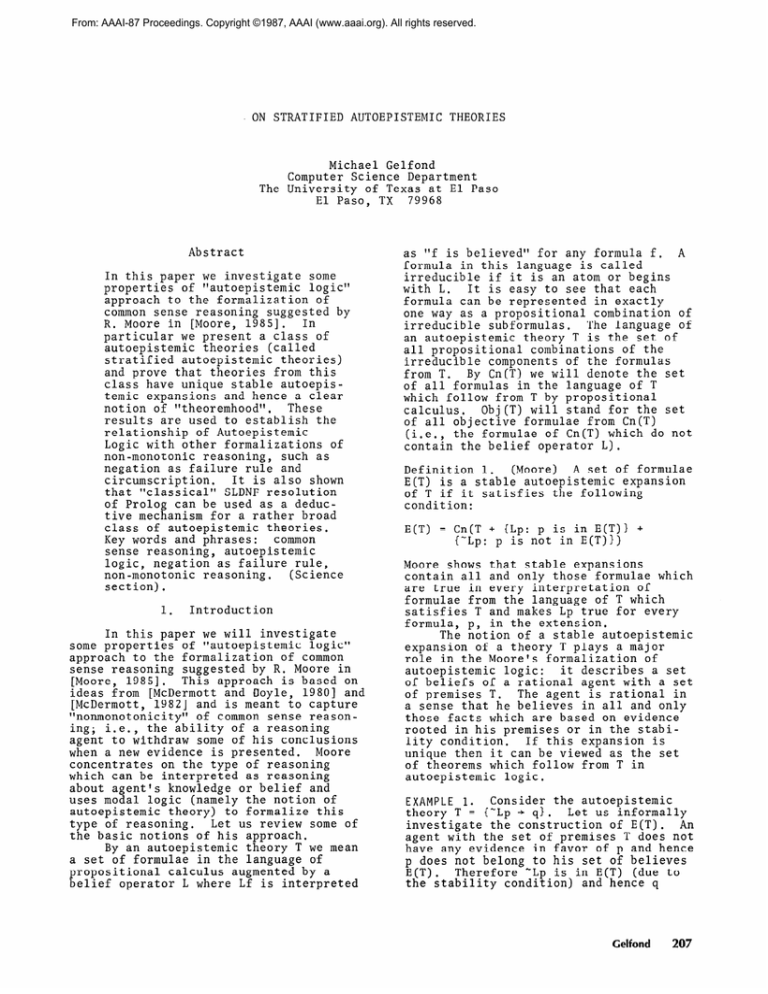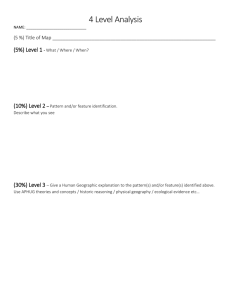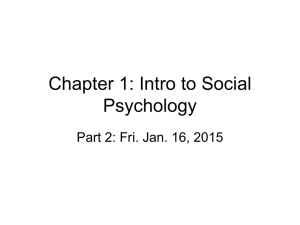
From: AAAI-87 Proceedings. Copyright ©1987, AAAI (www.aaai.org). All rights reserved.
ON STRATIFIED AUTOEPISTEMIC THEORIES
Michael Gelfond
Computer Science Department
The University of Texas at El Paso
El Paso, TX 79968
Abstract
In this paper we investigate some
properties of "autoepistemic logic"
approach to the formalization of
common sense reasoning suggested by
R. Moore in [Moore, 19851. In
particular we present a class of
autoepistemic theories (called
stratified autoepistemic theories)
and prove that theories from this
class have unique stable autoepistemic expansions and hence a clear
notion of "theoremhood".
These
results are used to establish the
relationship of Autoepistemic
Logic with other formalizations of
non-monotonic reasoning, such as
negation as failure rule and
It is also shown
circumscription.
that "classical" SLDNF resolution
of Prolog can be used as a deductive mechanism for a rather broad
class of autoepistemic theories.
common
Key words and phrases:
sense reasoning, autoepistemic
logic, negation as failure rule,
(Science
non-monotonic reasoning.
section).
1.
Introduction
In this paper we will investigate
some properties of "autoepistemic logic"
approach to the formalization of common
sense reasoning suggested by R. Moore in
[Moore, 19851. This approach is based on
ideas from [McDermott and Doyle, 19801 and
[McDermott, 19821 and is meant to capture
"nonmonotonicity" of common sense reasoning; i.e., the ability of a reasoning
agent to withdraw some of his conclusions
when a new evidence is presented. Moore
concentrates on the type of reasoning
which can be interpreted as reasoning
about agent's knowledge or belief and
uses modal logic (namely the notion of
autoepistemic theory) to formalize this
Let us review some of
type of reasoning.
the basic notions of his approach.
By an autoepistemic theory T we mean
a set of formulae in the language of
propositional calculus augmented by a
belief operator L where Lf is interpreted
"f is believed" for any formula f. A
Fzrmula in this language is called
irreducible if it is an atom or begins
with L. It is easy to see that each
formula can be represented in exactly
one way as a propositional combination of
irreducible subformulas. The language of
an autoepistemic theory T is the set of
all propositional combinations of the
irreducible components of the formulas
from T. By Cn(T) we will denote the set
of all formulas in the language of T
which follow from T by propositional
calculus. Obj(T) will stand for the set
of all objective formulae from Cn(T)
(i.e., the formulae of Cn(T) which do not
contain the belief operator L).
Definition 1. (Moore) A set of formulae
E(T) is a stable autoepistemic expansion
of T if it satisfies the following
condition:
E(T) = Cn(T + (Lp: p is in E(T)) +
{"Lp: p is not in E(T)))
Moore shows that stable expansions
contain all and only those formulae which
are true in every interpretation of
formulae from the language of T which
satisfies T and makes Lp true for every
formula, p, in the extension.
The notion of a stable autoepistemic
expansion of a theory T plays a major
role in the Moore's formalization of
autoepistemic logic: it describes a set
of beliefs of a rational agent with a set
of premises T. The agent is rational in
a sense that he believes in all and only
those facts which are based on evidence
rooted in his premises or in the stabiIf this expansion is
lity condition.
unique then it can be viewed as the set
of theorems which follow from T in
autoepistemic logic.
EXAMPLE
Consider the autoepistemic
1.
theory T = {"Lp + q}. Let us informally
investigate the construction of E(T). An
agent with the set of premises T does not
have any evidence in favor of p and hence
p does not belong to his set of believes
Therefore "Lp is in E(T) (due to
the stability condition) and hence q
E(T)
l
GdOd
207
is in E(T)
(due to agent's ability
to
reason)
and the only
objective
formulae
belonging
to E(T)
are those
from
Cn(g).
To construct
formulae
which
express
the
agent's
beliefs
about
objective
statements
we have
to add to E(T)
all formulae
of the form
Lf where
f is in Cn(q)
and
formulae
of the form
-Lf
if f is not in
In a similar
way we can construct
Cnh>.
agent's
beliefs
about
his beliefs
about
objective
formulae,
etc.
It is easy to
see that
the resulting
E(T)
is the only
stable
expansion
of T.
This
construction
as well
as the proof
of the uniqueness
of
E(T)
will
be discussed
in detail
in
Section
2.
Example
1 also illustrates
nonmonotonic
nature
of autoepistemic
logic.
The agent's
present
state
of
knowledge
forces
him to conclude
q.
But
if new information
about
p becomes
available
this
conclusion
can be withdrawn
which
reflects
the nonmonotonocity
of this
form
of reasoning.
Unfortunately,
as was
recognized
by
Moore,
a theory
T may have
more
than
one
stable
expansion
or even
no consistent
stable
expansion
at all.
To see why
let
us look
at the following
examples
from
[Moore,
19851:
EXAMPLE
2.
Let T = {-Lp + ~1.
A theory
T has no consistent
stable
expansion.
Informally:
we have
no evidence
for p,
hence
we conclude
that
-Lp which
leads
us
to p and therefore
Lp.
Contradiction.
EXAMPLE
3.
Let T = {%Lp + q, -Lq +p1.
It
is easy
to see that
T has two stable
expansions:
El with
an objective
part
Cn(q)
and E2 with
an objective
part
Cn(p).
This
raises
an important
question
of
characterization
of autoepistemic
theories
with
unique
stable
expansions
(i.e.,
clear
notion
of "theoremhood").
This
question
was first
addressed
in [Marek,
19861.
His
results
immediately
imply
the following
theorem:
(Marek)
Any consistent
THEOREM
1.
objective
theory
T (i.e.,
consistent
theory
without
the belief
operator)
unique
stable
expansion
E(T).
has
a
In the first
part of this
paper
we
will
generalize
this
result
and give
sufficient
conditions
which
guarantee
the
existence
of a unique
stable
expansion
for
a much
broader
class
of theories
T.
Theories
from
this
class
will
be called
stratifiable
autoepistemic
theories.
Informally
the notion
is based
on requiring
the presence
of certain
hierarchy
of predicates
defined
by a theory
T which
allows
the use of formulae
of the form
Lf on the
level
k of this
hierarchy
only
if f itself
is fully
defined
on the lower
levels.
The second
part
is devoted
to the
investigation
of the relationship
between
208
Mautoepistemic
logic"
formalization
of
common
sense
reasoning
and the alternative
formalization
based
on the "negation
as
used
in logic
programming.
failure
rule"
We start
with
the review
of the definition
of stratified
logic
programs
and their
semantics
[Apt et al,
19861
[Van Gelder,
19861 and then show that stratified
logic
programs
can (in some
precise
sense)
be
This,
interpreted
in terms
of belief.
together
with
results
from
[Lifshitz,
19861,
[Gelfond,
Przymusinska,
19861
establishing
the relationship
between
autoepistemic
logic
and
circumscription,
stratified
logic
programs
shows
that
in
the presence
of a suitable
hierarchy
of
definitions
in a knowledge
base
different
formalizations
of nonmonotonicity
in
common
sense
reasoning
essentially
coincide.
Another
important
consequence
of
this
result
is that
it gives
us a feasible
deductive
procedure
we can use to characterize
theorems
of a broad
class
of
autoepistemic
theories.
To give
a flavor
of the techniques
used
to prove
these
results
we include
the
Complete
complete
proof
of theorem
2.
proofs
of other
results
will
be published
elsewhere.
2.
Stratified
Autoepistemic
Theories
By literals
we mean
formulae
of the
p is a propoforms
p, -p, Lf, "Lf where
sitional
letter
and f is an objective
Literals
which
contain
the
formula.
L will
be called
autobelief
operator
epistemic
while
those
without
L will
be
From
now on we will
called
objective.
restrict
our attention
to autoepistemic
theories
consisting
of clauses
of the
form
S-+Vwhere
S is a list
of literals
and V is a list
of atoms
(both
S and V can
be empty).
An autoepistemic
theory
T
1.
stratified
if there
is a
such
that:
T = To + . . . + T
Tpossibly
empty)
is objective
T
c B auses
with
the empty
conclusions
do not belong
to Tk where
k > 0.
(iii)
if a propositional
letter
p
belongs
to the conclusion
of a
clause
in Tk then
literals
p and
-p do not belong
to T
Tk-I
and literals
Lf @hd'"LS
where
f contains
p do not belong
to To,
. . . . Tk.
We will
say that
the degree
of a propositional
letter
p is k and write
D(p)
= k if
p belongs
to the conclusion
of a clause
in
If there
is no such
clause
then
the
Tk.
(It
is obvious
that
if
degree
of p is 0.
an autoepistemic
theory
is stratified
then
every
propositional
letter
p has
The degree
of an
exactly
one degree).
objective
formula
f is the maximum
degree
DEFINITION
is called
partition
(i>
(ii)
of
its
propositional
letters.
is easy
to see that
theories
from
Examples
2 and 3 are not stratified
while
the theory
from
Example
1 is stratified
with
T
= ( 1 and Tl = {"Lp
-> q1
W& will
start
with
a construction
of
The
idea
is
the stable
expansion
of T.
to first
build
the objective
core
of such
an expansion
and then
to apply
Marek's
Such
an objective
construction
to it.
core
is build
gradually
by expanding
the
corresponding
layers
of the stratified
theorv
T.
More
preciselv:
= Cn(T
).
'
Kg
+ (Lp:D(p)
= m & p in Km} +
Km+
1=
f nK,
(
("Lp:D(p)
= m & p not in Km} +
1.
Tm+
The fol \ owing
simple
lemmas
capture
important
properties
of this
construction.
It
can be
Any model
Mm of I$-,,
1.
LEMMA
expanded
to a model
Mm+1 of Kmtl.
= Mm + (Lp : D(p)
= m & p
Proof.
Let Mm+
It can be
in Km1 + (q : D t q) = m+l}.
easily
seen
from
the definition
of stratified
autoepistemic
theories
that
Mm+1
is
indeed
a model
of Km+l.
qftt+eory
Km is consistent
m 1s consistent.
(b)
Km+l' is a conservative
extension
of Km.
Follows
immediately
from
Lemma
Proof.
Now we can construct
a stable
expansion
E of T.
LEMMA
2.
(a)
1.
Let K = Kn where
Tn is the
DEFINITION
2.
K is
last
layer
of the partition
of T.
consistent
and hence,
in virtue
of Theorem
1, there
is a unique
stable
expansion
of
Let us denote
it by E.
obj(K).
To show
that
E is indeed
a stable
expansion
of T we need
the following
Lemma.
For any objective
formula
f of
LEMMA
3.
iff f in E.
degree
m, f in obj(Km)
Proof.
The only
if part
is obvious.
To
prove
the if part
it suffices
to notice
that
f in E implies
f in obj(K)
(see
Theorem
2 from
[Marek,
19861
and hence,
by
clause
(b) of Lemma
2, we have
that
f is
in obj(Km).
THEOREM
2.
Any consistent
and stratified
autoepistemic
theory
T has a stable
expansion
E(T).
Proof.
To show
that
E is a stable
expansion
of T we have
to prove
that
E
satisfies
the following
condition:
(1) E =-Cn(T+{Lf:
f in EI +
{"Lf:
f not in El).
Let us denote
the set on the right
side
of
From
the definition
this
equation
by R.
of E we have
that
(2) E = Cn(obj(K)
+ {Lf:
f in EI +
C"Lf:
f not in El).
and hence
it remains
to show
that
R = E.
(a)
To show
that
E is in R let us prove
We will
first
that
for any m, Km in R.
The base
is obvious
use induction
on m.
and the inductive
step
follows
immediately
Now it suffices
to notice
from
Lemma
3.
that,
by the definition
of K, obj(K)
is
in R.
(b)
To show
that
R is a subset
of E we
will
prove
that every
model
of E is a
Suppose
it is not the case
model
of R.
and there
is a model
M of E which
is not
Let U = (S --> V) be a
a model
of R.
clause
from
T of the lower
degree
m such
that
V is not empty
and M(S)
= True
and
It is easy to see that
M(V)
= False.
such
clause
always
exists
and its premise
S must
contain
autoepistemic
literals
(otherwise
U would
be in obj(K)
and false
Suppose
that
in M which
is impossible).
Since
E
the first
such
a literal
is Lq.
autoepistemic
literals
is complete
w.r.t.
(i.e.,
E I- Lq or E I- *Lq)
and M(Lq)
=
The theory
True
we have
that
q is in E.
therefore
the degree
T is autoepistemic,
of q is less
than m, by Lemma
3 we have
that
q is in Km-l
and hence
Lq is in Km.
Now we can eliminate
Lq from
S and obtain
Ul which
belongs
to Km and fails
a clause
If the first
autoepistemic
literal
in M.
in
in S is "Lq it can be eliminated
By repeating
exactly
the same manner.
this
process
we will
eventually
obtain
a
clause
Ur which
is objective,
belongs
to
Km and fails
in M which
contradicts
our
Hence
R is a subset
of E.
assumption.
Q.E.P.
THEOREM
sion
of
3.
T.
3.
E
is
the
Stratified
only
Logic
stable
expan-
Programs
We will
start
with
recalling
the
notion
of stratified
logic
program
(for
the propositional
case)
and its semantics
19861,
[Van Gelder,
(see
[Apt.
et al.,
program
we mean
a
i986] j: By a logic
collection
of clauses
of the form
S --> p
where
S is a (possibly
empty)
list
of
literals
and p is a propositional
letter,
Logic
programs
are used
to answer
queries
of the form
11 V.. Vln where
11, . . . . In
In this process
the
are literals.
'negation
as failure
rule'
is used
which
makes
the precise
definition
of the
notion
of an answer
to a query
Q somewhat
Recently
difficult
to come
up with.
several
researchers
independently
suggested
the characterization
of a class
of logic
programs
for which
this
notion
allows
elegant
and clear
semantics.
A logic
program
LP is
3.
called
stratified
if there
is a partition
LP = TD + . . . + Tn such
that
if a propositional
letter
p belongs
to the conclusion
of a clause
in Tk then
p does
not
belong
to TO,
. . . . Tk-1
and "p does
not
belong
to TO,
. . . . Tk.
DEFINITION
Gelfond
209
Stratifiability
is a condition
on
the use of negation
in a logic
program.
Intuitively
it forbids
use of negation
on formulas
which
are not completely
defined.
REMARK
The following
corollary
of Theorem
5
establishes
the relationship
between
autoepistemic
theories
and prioritized
circumscription
(see
[McCarthy,
19861).
EXAMPLE
4.
It is easy to see that a
program
p, p --> q, -q --> r is stratified
with
TO = {p, p --> q} and Tl =
{"q --> r).
The notion
of an answer
to
a stratified
program
LP is based
following
definition:
a
query
on the
for
Consider
a sequence
of
DEFINITION
4.
theories
ELPk
(where
ELP stands
for an
'extension
of logic
program')
such
that
there
is no
ELPO
= CWA(T0)
+ {'"p:
clause
in LP with
a conclusion
~1:
ELPk+1 = CWA(ELPk + Tk+l);’
ELP = ELPk;
where
CWA(T)
is Reiter's
Assumption
of a theory
T
CWA(T)
= T + {--p: T I-/-
PROPOSITION
1.
For
+ . . . + T,,
LP = To
has the
unique
any
ELP
*
Closed
Work
(see
[R])i.e.,
p).
stratified
theory
is consistent
and
model.
This
model
is intended
to represent
the universe
described
by LP.
(It
can be
shown
that model
is exactly
the
model
of LP defined
in
"canonical"
[Apt,
et al.].
The notion
of "an answer
to a query
Q" is defined
as follows:
5.
We will
say that
the query
LP has a positive
answer
and write
in M.
Otherwise
LP I = Q iff Q is true
the answer
to Q is negative.
DEFINITION
Q
in
4.
The
Relationship
To investigate
the relationship
between
logic
programs
and autoepistemic
theories
we will
need
a suitable
mapping
I from the propositional
language
in which
logic
programs
are written
into
the
corresponding
language
with
the belief
operator
L.
For any propositional
DEFINITION
6.
is the formula
obtained
formula
f, I(f)
from
f by replacing
every
occurrence
of
-p in f by the
every
negative
literal
For
neqative
autoepistemic
literal
"Lo.
’
any logic
program
LP, I(LP)
=
{I(S):S
in LPI.
For any stratified
THEOREM
4.
there
is a unique
autoepistemic
E of I(LP).
THEOREM
and for
210
5.
any
Planning
For any stratified
query
Q, LP 1 = Q
program
LP
expansion
program
LP
iff E I-I(Q)
For any stratified
program
LP
COROLLARY.
and any query
Q we have
CIRC(LP,Pl
>
Proof
> Pn) I= Q iff E(LP)
I- I(Q).
follows
immediately
from
Theorem
3.1 of
[Ll],
definition
of ELP and Theorem
5.
(On the relationship
of circumscription
and logic
programs
see also [LB6 and P861).
5.
Conclusion
The Moore's
formalization
of autoepistemic
logic
is based
on the notion
of
stable
autoepistemic
expansion
of a theory
T which
represents
a possible
set of
beliefs
of a rational
agent
with
a set of
premises
T.
If such an expansion
of a
theory
T is unique
then
it can be viewed
as the set of theorems
derivable
from
T
In this paper we
in autoepistemic
logic.
introduced
a notion
of stratified
autoepistemic
theory
and showed
that
such
theories
have
unique
stable
expansions.
We believe
that
this
result
is of some
importance
not only
because
it clarifies
the notion
of "theoremhood"
in autoepistemic
logic
but also
because
of the
following
reasons:
(a)
Like
many
other
nonmonotonic
autoepistemic
logic
reasoning
systems,
Neither
was presented
non-constructively.
the semantic
basis
nor the syntactic
realization
of this
semantic
provided
a
mechanism
for arriving
at the theorems
of
We use the
a given
autoepistemic
theory.
notion
of stratification
to show
that
SLDNF
resolution
of Prolog
"classical"
can be used
as such
a mechanism
for a
rather
broad
class
of autoepistemic
theories.
This
result
also
allows
us to
interpret
the behavior
of systems
based
on (propositional)
Prolog
in terms
of
belief
and suggests
possible
directions
in which
Prolog
can be extended
to autoepistemic
theories.
(b)
The results
of this
paper
suggest
that
a designer
of a knowledge
system
based
on autoepistemic
logic
may find
it
both
conceptually
and compurewarding,
tationally,
to restrict
yourself
to
stratified
autoepistemic
theories
(very
much
as a designer
of a traditional
software
system
may find
it rewarding
to
restrict
yourself
to traditional
data
structures
such
as stacks,
trees,
etc.).
It is possible
that
other
syntacticly
described
classes
of autoepistemic
theories
more
suitable
for some
types
of
But,
in
applications
will
be discovered.
my judgement
to make
autoepistemic
approach
really
practical
we have
to first
extend
it to allow
quantification.
(c)
Autoepistemic
logic
is based
on an
intuition
rather
different
from
those
used
for the development
of other
formalisms
of this
sort
such
as negation
as failure
rule
or circumscription.
We
believe
that
the better
understanding
of
the relationship
between
different
forms
of non-monotonic
logic
is essential
for
It may help to
further
development.
single
out areas
of applicability
of
find
their
limitations
and
these
methods,
even
eventually
lead
to the discovery
of
deeper
underlying
principals
of
non-monotonic
reasoning.
6.
I am
and Halina
discussions
[Reiter,
In:
and
[Van
19781
On Closed-World
Databases
Logic
and Databases
(H. Gallaire
J. Minker,
Eds),
1978.
Gelder,
19861
Negation
Using
Tight
Derivations
Logic
Programs,
Third
on Logic
Programming,
as Failure
for General
IEEE Symposium
1986.
Acknowledgements
grateful
to Vladimir
Lifshitz
Przymusinska
for numerous
on the subject
of this
paper.
References
7.
[Apt,
[Przymusinski,
19861 On the Semantics
of
Stratified
Deductive
Databases.
In:
Preprints
of Workshop
on Foundations
of Deductive
Databases
and Logic
Programs,
1986.
Blair,
and Walker,
19861 Toward
a
Theory
of Declarative
Knowledge,
In:
Preprints
of Workshop
on Foundations
of Deductive
Databases
and Logic
Programs,
1986.
[Gelfond
and Przymunsinska,
19861
On the
Relationship
between
Circumscription
Proceedand Autoepistemic
Logic.
ings of International
Symposium
on
Methodologies
for Intelligent
Systems,
1986.
[Lifschitz,
19851 Closed-World
Databases
.
and Circumscription.
Artificial
Intel1
igence
27,
1985.
[Lifschitz,
19861 On the Declarative
Semantics
of Logic
Programs
with
Preprints
of WorkNegation.
In:
shop
on Foundations
of Deductive
Databases
and Logic
Programs,
1986.
19851
Semantical
[Moore,
Nonmonotonic
Logic,
Intelligence
25 (l),
[Marek,
19861
epistemic
Stable
Logic,
Considerations
Artificial
on
1985.
Theories
in
(Preprint),
Auto-
1986.
[McCarthy,
19861 Applications
of Circumscription
to Formalizing
Common
Sense
Reasoning,
Artificial
Intelligence
28,
1986.
[McDermott
Logic
and Doyle,
19801
Nonmonotonic
1, Artificial
Intelligence
13,
1980.
19821
[McDermott,
Nonmonotonic
29,
Nonmonotonic
Logic
Modal
Theories,
J.
2:
ACM
1982.
Gelfond
211








